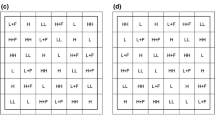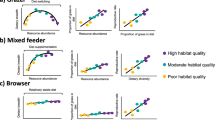Abstract
We tested the idea that ruminants allocate their feeding time to habitat patches in relation to foraging efficiency. We used five tame red deer (Cervus elaphus) in an enclosure planted with four treatment of timothy grass (Phleum pratense) differing in their stage of growth. Older swards offered higher biomass but lower nutritional quality than younger swards. We observed time spent feeding in each treatment during each of seven trials. We measured goodness-of-fit between observed times and predictions from two alternative hypotheses differing in optimization strategy (maximizing versus matching), and a third, null hypothesis. We tested the hypotheses using two alternative currecies: digestible protein, and digestible dry matter or energy. Although digestible protein concentration and dry-matter digestibility were highly correlated (r=0.763, P<0.001), the wider range of digestible protein made it the much more sensitive measure of forage quality. Distributions of feeding time closely matched estimated intake rates of digestible protein (R sup2infPred =0.899) across all animals and trials. The other hypotheses were rejected. The results have important ecological implications in showing the underlying role of food in the selection of habitat by ruminants, and that simple, mechanistic models of forage intake and digestion can be scaled up to the level of animal behavioural choices.
Similar content being viewed by others
References
Albon SD, Langvatn R (1992) Plant phenology and the benefits of migration in a temperate ungulate. Oikos 65:502–513
Bunnell FL, Gillingham MP (1985) Foraging behavior: dynamics of dining out. In: Hudson RJ, White RG (eds) Bioenergetics of wild herbivores. CRC Press, Boca Raton, Fla, pp 53–79
Casella G (1983) Leverage and regression through the origin. Am Stat 37:147–152
Fox JL (1991) Forage quality of Carex macrochaeta emerging from Alaskan alpine snowbanks through the summer. Am Midl Nat 126:287–293
Goering HR, Van Soest PJ (1970) Forage fiber analysis. United States Department of Agriculture, Agricultural Research Service, Agricultural Handbook no. 379
Gordon IJ (1989a) Vegetation community selection by ungulates on the Isle of Rhum. II. Vegetation community selection. J Appl Ecol 26:53–64
Gordon IJ (1989b) Vegetation community selection by ungulates on the Isle of Rhum. III. Determinants of vegetation community selection. J Appl Ecol 26:65–79
Hanley TA (1984) Habitat patches and their selection by wapiti and black-tailed deer in a coastal montane coniferous forest. J Appl Ecol 21:423–436
Hanley TA, Robbins CT, Hagerman AE, McArthur C (1992) Predicting digestible protein and digestible dry matter in tannin-containing forages consumed by ruminants. Ecology 73:537–541
Herrnstein RJ (1970) On the law of effect. J Exp Anal Behav 13:243–266
Illius AW, Wood-Gush DGM, Eddison JC (1987) A study of the foraging behaviour of cattle grazing patchy swards. Biol Behav 12:33–44
Illius AW, Clark DA, Hodgson J (1992) Discrimination and patch choice by sheep grazing grass-clover swards. J Anim Ecol 61:183–194
Kamil AC, Roitblat HL (1985) The ecology of foraging behavior: implications for animal learning and memory. Annu Rev Psychol 36:141–169
Klein DR (1965) Ecology of deer range in Alaska. Ecol Monogr 35:259–284
Langvatn R, Albon SD (1986) Geographic clines in body weight of Norweigan red deer: a novel explanation of Bergmann's rule? Holarctic Ecol 9:285–293
MacArthur RH, Pianka ER (1966) On optimal use of a patchy environment. Am Nat 100:603–609
Morgantini LE, Hudson RJ (1989) Nutritional significance of wapiti (Cervus elaphus) migrations to alpine ranges in western Alberta, Canada. Arct Alp Res 21:288–295
Mould ED, Robbins CT (1981a) Nitrogen metabolism in elk. J Wildl Manage 45:323–334
Mould ED, Robbins CT (1981b) Evaluation of detergent analysis in estimating nutritional value of browse. J Wildl Manage 45:937–947
Mould ED, Robbins CT (1982) Digestive capabilities in elk compared to white-tailed deer. J Wildl Manage 46:22–29
Myers RH (1986) Classical and modern regression with applications. Duxbury Press, Boston, Mass
Robbins CT (1983) Wildlife feeding and nutrition. Academic Press, New York
Saeboe B (1982) A population-genetic study of spiked grass with emphasis on content of silicon (in Norwegian). Norges landbruksvitenskaplige forskningsråd, NLVF, Report no. 412, 16 pp
Stephens DW, Krebs JR (1986) Foraging theory. Princeton University Press, Princeton, NJ
Van Soest PJ (1982) Nutritional ecology of the ruminant. O and B Books, Corvallis, Ore
Westoby M (1974) Analysis of diet selection by large generalist herbivores. Am Nat 108:290–304
Westoby M (1978) What are the biological bases of varied diets? Am Nat 112:627–631
White RG (1983) Foraging patterns and their multiplier effects on productivity of northern ungulates. Oikos 40:377–384
Wickstrom ML, Robbins CT, Hanley TA, Spalinger DE, Parish SM (1984) Food intake and foraging energetics of elk and mule deer. Wildl Manage 48:1285–1301
Wilm HG, Costello DF, Klipple GE (1944) Estimating forage yield by the double sampling method. J Am Soc Agron 36:194–203
Author information
Authors and Affiliations
Rights and permissions
About this article
Cite this article
Langvatn, R., Hanley, T.A. Feeding-patch choice by red deer in relation to foraging efficiency. Oecologia 95, 164–170 (1993). https://doi.org/10.1007/BF00323486
Received:
Accepted:
Issue Date:
DOI: https://doi.org/10.1007/BF00323486




